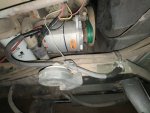That is exactly what you should do, except you have to also change the alternator

I plan on shifting to a straight 24V alt and equalizer if/when my 24/12 alt fails... not necessarilly because of the way the alt works, but because of the VERY high cost of the 24/12 neihoff’s compared to the commercially available 24V alts and equalizers.
The 24/12 Neihoff regulator is designed to charge AND balance series wired 12V batteries. Its regulator is looking for that 12V buried within the 24V series string, and will keep the alternator offline if it doesn’t see it(Discovered this trying to separate and measure actual electrical loads/power needs

)
In the case of the 100A Neihoff, 24V@ 50A is 1200W. 12V@ 50A is 600W for a total of 1800W output. If you could stop using the 12V output, your available output/supply would drop by 1/3.
Not sure what the breakdown for the OP’s 260A alternator is, but this isn’t really an issue as long as he keep the 24V side adequately loaded, which is why I brought up the subject. The Neihoff reg does a pretty good job of balancing the batteries. I think the biggest cause of issues with the LMTV electrical system was the pairing of the 100A alt with the grossly oversized battery bank. This leads to regular occurrences of partial battery charge(usually 12V) and near constant alternator overload and failure... I think that is why the A1R got the 260A alt. Thats the alt the A0 should have gotten

 www.dometic.com
www.dometic.com






